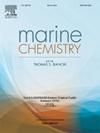羰基硫化物水解过程中的硫同位素分馏
IF 2.5
3区 地球科学
Q2 CHEMISTRY, MULTIDISCIPLINARY
引用次数: 0
摘要
羰基硫化物(OCS)是大气中最丰富的含硫气体,被用作陆地总初级生产力(GPP)的替代物。海洋是大气中 OCS 的主要来源,由光化反应和 "暗 "反应产生。水解为 H2S 和 CO2 是海洋表面 OCS 的主要清除过程。测量与这些主要 OCS 源和汇相关的硫同位素值(δ34S)和同位素分馏(ε)可以减少其通量的不确定性。本研究旨在测定 OCS 水解过程中的ε(εh)。我们使用了与 GC/MC-ICPMS 相耦合的吹扫捕集系统,测量了在不同温度(4-40 °C)、盐度(0.2-40 g/L)和 pH 值(4-9)条件下水解过程中的δ34S 值,这些条件代表了不同的自然环境条件。此外,我们还使用量子化学方法计算了平衡εh,并将其与经验结果进行了比较。我们对低盐度(S =0.2 g/L;pH 8.0)水的研究结果表明,εh 与温度有关,从 -3.9 ‰ ± 0.2 ‰(4 °C)到 -2.2 ± 0.6 ‰(40 °C)。低温下较高的分馏率对冰芯数据的解释有影响。然而,在 4 ℃ 和 22 ℃ 的天然海水中(S = 40 g/L,pH 值为 8.2),没有这种温度依赖性,εh 平均为 -2.6 ± 0.3 ‰。因此,在接近水的凝固温度时,盐度似乎可以抵消温度效应。在 22 ℃ 条件下,pH 值在 4 和 9 之间变化不会导致任何 εh 变化趋势。Ab-initio 计算表明,OCS 的水解不受平衡控制。我们报告的 εh 值将有助于量化 OCS 的水解作用对海洋和淡水环境中可观测到的 OCS 硫同位素特征的影响。这反过来将有助于更准确地计算从海洋到大气的 OCS 预算的质量平衡。本文章由计算机程序翻译,如有差异,请以英文原文为准。
Sulfur isotopic fractionation during hydrolysis of carbonyl sulfide
Carbonyl Sulfide (OCS) is the most abundant sulfur-containing gas in the atmosphere, and it is used as a proxy for terrestrial gross primary productivity (GPP). Oceans are the major source of OCS to the atmosphere, produced by photochemical and “dark” reactions. Hydrolysis to H2S and CO2 is the major removal process of OCS from the ocean's surface. Measuring the sulfur isotope values (δ34S) and the isotopic fractionation (ε) associated with these major OCS sources and sinks could decrease the uncertainties in its fluxes. In the current study, we aim to determine the ε during the hydrolysis process of OCS (εh). We used a purge and trap system coupled to a GC/MC-ICPMS to measure δ34S values during hydrolysis under different temperatures (4–40 °C), salinities (0.2–40 g/L), and pH (4–9), representing various natural environmental conditions. In addition, we use the quantum chemical method to calculate the equilibrium εh and compare it to the empirical results. Our results for the low salinity (S =0.2 g/L; pH 8.0) water show a temperature dependency of the εh from −3.9 ‰ ± 0.2 ‰ (4 °C,) to −2.2 ± 0.6 ‰ (40 °C). The higher fractionation at low temperatures has implication for ice-core data interpretation. However, in natural seawater at 4 and 22 °C (S = 40 g/L, pH 8.2) there was no such temperature dependency and the εh averaged −2.6 ± 0.3 ‰. Thus, it seems that salinity cancels the temperature effect close to the freezing temperature of water. Varying the pH between 4 and 9 (at 22 °C) did not result in any εh trend. Ab-initio calculations suggest that OCS hydrolysis is not controlled by equilibrium. The εh values we report will aid in quantifying the impact of OCS's hydrolysis on the observable sulfur isotopic signature of OCS in oceanic and in freshwater environments. This in turn will facilitate more accurate mass-balance calculations for the OCS budget from the ocean to the atmosphere.
求助全文
通过发布文献求助,成功后即可免费获取论文全文。
去求助
来源期刊

Marine Chemistry
化学-海洋学
CiteScore
6.00
自引率
3.30%
发文量
70
审稿时长
4.5 months
期刊介绍:
Marine Chemistry is an international medium for the publication of original studies and occasional reviews in the field of chemistry in the marine environment, with emphasis on the dynamic approach. The journal endeavours to cover all aspects, from chemical processes to theoretical and experimental work, and, by providing a central channel of communication, to speed the flow of information in this relatively new and rapidly expanding discipline.
 求助内容:
求助内容: 应助结果提醒方式:
应助结果提醒方式:


